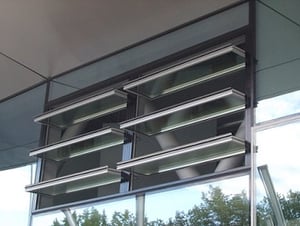 You may think that fitting an actuator on a window instead of using a smoke ventilator will make a cost effective solution for smoke and natural ventilation, but unfortunately it is not that simple.
You may think that fitting an actuator on a window instead of using a smoke ventilator will make a cost effective solution for smoke and natural ventilation, but unfortunately it is not that simple.
Here are some of the ways in which a window/actuator combination can be a poor substitute for a smoke ventilator:
The window and actuator will not comply to EN standards. Smoke Ventilators are, in most instances, part of a life safety system designed and installed in buildings to help people escape in the event of fire or to protect firefighters as they enter the building to tackle the fire.
For this reason, the design, manufacture and testing of smoke ventilators is covered by the Construction Products Regulation and ventilators should be CE marked to EN 12101-2. Worryingly, there seems to be an increasing number of both window and actuator manufacturers claiming that their products in isolation meet the requirements of this standard. Put simply, an actuator tested without the window cannot comply with this standard. Likewise neither can a window without an actuator.
To compound the problem further there are also 3rd party certification bodies out there prepared to certify individual components in this way. Granted, the certificate may state that the actuator is only tested to a particular characteristic, reaction to heat for example, but without knowing the workings of the CPR or EN standards in detail, most people will take a third party certificate at face value.
The window and actuator may be incompatible. These two ‘off the shelf’ components are often supplied by two different parties in the construction process. Rarely is the compatibility of the components considered adequately. For example, a window with sliding/scissor hinges has a vertical action, whereas an actuator’s chain drive would normally operate in the horizontal plane. If the motor drives too far, the hinge mechanism may lock up with the potential for damage when the window tries to close. Similarly, a UPVC or timber framed window may not have the strength in the right areas to take the loads being imposed by a high powered actuator, particularly if it is badly aligned. And, if you run into such a problem, where does responsibility for the incompatibility lie?
A window with an actuator is not tested as assembly. Compared to ventilators, a window with an actuator won’t generally be tested as an assembly. This is important because the hinges and seals are not designed for continuous opening and closing by mechanical force. Unless it’s tested as an assembly, you won’t know how well – or how badly – it will work over time. You don’t want it to fail when you most need it during a fire!
You won’t necessarily achieve the right area. Just fitting actuators on your windows means that you won’t necessarily be relying on a properly designed ventilation system: who takes responsibility for ensuring that the right area is being achieved with your simple window? Approved Document B recommends a free area of 1.5m2 to achieve an effective natural smoke ventilation system. More information on free areas can be found in the recently updated SCA guidance.
Excessive cost and flexibility of controls. A contractor will tend to supply an actuator at the lowest price, so you might get a 24V 6A actuator. This component doesn’t cost much, but it has a high power demand. Control issues may arise in this situation, as a higher power demand can often lead to needing large back-up power supplies, as well as restrictive cable lengths.
Are you sure that your actuated window can provide proportional and controlled opening, or is it just open/close? For effective day to day ventilation, you need a system that has the ability for modulating control.
Why you should use ventilators instead
Purpose designed and tested. Ventilators are designed precisely for smoke and natural ventilation. Norms in Europe require them to be to tested to at least 1,000 cycles for smoke and a minimum of 10,000 cycles for day-to-day ventilation.
Tested as one assembly. Such ventilators are tested as one assembly to withstand pre-determined wind loads and snow loads (if they are not installed vertically), for air flow and for high temperature operation to the relevant standard. The hinges and seals are selected to withstand the forces of continuous opening and closing.
A larger free area. A louvred ventilator (which is nearly always fitted with an integrated actuator) will generally provide a larger free area than a single pane window for a given size of opening.
A safer opening. A louvred ventilator operates more safely, being able to restrict ingress and egress, as the opening aperture can be determined by selecting the number and size of louvres. This is a particular advantage in education establishments.
Assured modulating control. The controls and actuators can be selected to provide the ability for modulating control.
They look good. The actuators are integral to the unit, so they don’t look like an afterthought added at a later date.
A guaranteed product. There is a single line of responsibility for the entire system, guaranteeing the service it is meant to provide.
Conclusion
While fitting actuators on windows may seem like an attractive low-cost solution, you should resist the temptation and choose purpose-designed ventilators and when someone offers you a certificate for a product, whether independent or not – read the small print.
If you would like to know more, why not contact us or read about natural ventilation on our website.
 Conor Logan is a Technical Manager of Colt UK, Smoke and Climate Control Division. Conor designs innovative smoke control and HVAC systems and is also Chairman of the Smoke Control Association.
Conor Logan is a Technical Manager of Colt UK, Smoke and Climate Control Division. Conor designs innovative smoke control and HVAC systems and is also Chairman of the Smoke Control Association.


